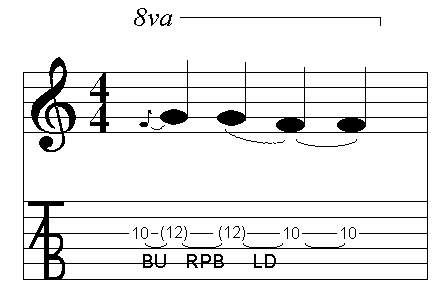
I've included a few examples of music on this website in both conventional music notation and also in tablature. I was recently asked a question (through the AllExperts website) to provide an explanation of how to read tablature, so here goes...
Tablature (sometimes just called 'tab') is a style of notation, aimed at guitarists, which is more simplistic than conventional music notation. It uses six horizontal lines to represent the strings of the guitar, with the bottom E 'line' on the bottom and the top E 'line' at the top. Incidentally, you may also see tablature for bass guitar, which uses 4 lines representing the strings of the bass. Instead of marking notes on the lines using dots, tablature uses numbers to represent the fret where you should play a note. Because this system doesn't convey the phrasing of the piece, it is usual to see a piece written in both conventional notation and music notation - you can use the conventional music notation to see the timing/phrasing of notes, while the tablature provides an easy-to-read description of where to play notes on the guitar neck.
This tutorial covers the common symbolds, etc. that appear in tablature. There are lots and lots of specific notations for the multitude of techniques available to the guitarist, but what's covered here should be enough to get you through most of the tablature that you come across. Also, it's worth mentioning that all music writes and transcribers have their own personal style for writing notation and tab, much in the same way that we all have our own distinctive styles of handwriting, so examples that you see elsewhere might look slightly different to the examples that I've got here.
Let's look at a basic example of a riff written in tablature:
As well as the basic idea of showing you which frets to play notes at, this example also includes a couple of other pieces of notation that are worth pointing out. Firstly, notice that the picking direction is shown just above the tablature lines (the squared-n shape denotes a down-stroke and the v shape denotes an upstroke). This doesn't always appear in tablature, but will often be shown if the picking direction is important (such as for a picking exercise).
Also note the last triplet pattern here. This is played as a 'slur' which is denoted in the music notation with the tie below the notes,.. When you play these three notes on the guitar you would hammer-on from one note to another (i.e. bring your fretting finger down on the neck without actually picking the note with your right hand). The hammer-on effect is shown in the tablature with the 'H' symbol next to the tied notes.
There are several types of slur that can be denoted in tablature. Have a look at the following example:
There are several types of slur denoted here - let's look at them one at a time.
The first two are hammer-ons, like we saw in the previous example, and notated with an 'H'. The second hammer on also has a 'T' marked above the tab line, in a circle. This symbol means 'tap' and is an instruction to play the hammer-on using a finger of your right hand on the neck (two-handed tapping is a technique which often crops up in rock guitar, but don't worry about it now if you aren't familiar with the technique).
The next slur uses a pull-off (i.e. you take your fretting finger off the string without actually picking the string with your right hand) and this pull-off is notated with a 'P' symbol.
Finally, the transition to the last note uses a slide, and this is shown in the tablature with an 'S'.
String bending often gets used in guitar playing and symbology exists in tablature to allow this to be written accurately.
Here's a snippet of music showing an example of string bending.

This example starts with the 3rd string being bent from a F note at the 10th fret to a G. The note that results from the bend sound like the note at the 12th fret, but of course you're still fretting at the 10th (the extra couple of semitones are achieved from the bend). Consequently, the 12 is shown in the tablature within brackets, meaning the note that sounds like the note played on that string at the 12th fret. Also, the bend up is denoted with the 'BU' symbol.
Here, the bent note is repicked ('RPB' = Re-Pick Bend) and then released to the unbent note ('LD' = 'Lower Down'). This final note is heldfor a further beat, so the notation shows two tied notes without any specifal notation.
Let's round this tutorial off with a quick look at how harmonics are shown in tablature (if you aren't sure what harmonics are, or how to play them, then there's a tutorial which covers them elsewhere on this website).
Harmonics are shown using a diamond symbol around the fret number to indicate whereabouts you should play the node point of the harmonic. Usually the tab will include some additional notation to indicate a harmonic (such as 'NH' or 'AH' to indicate a natural or an artifical harmonic).

How useful did you find this tutorial?
| Product/Info... | PhatPhish Application | | | Product Help | | | GUPPY - PhatPhish for the web | | | About The Author |
|---|
| Get Stuff... | Download PhatPhish | | | Mechandise | | | Blank Stave And Tab Sheets | | | Tutorials |
|---|
| Do Stuff... | Register | | | Feedback | | | Links | | | Donate | | | Ask A Question |
|---|
| Social Media... | YouTube | | | | |
|---|
| Promote... | Spread The Word | | | Posters/Flyers |
|---|
| Play... | PhatPhish Picks - Boutique Plectrums |
|---|
| ©2002-2022, Dave Dixon / CyberFlotsam http://www.cyberflotsam.com |